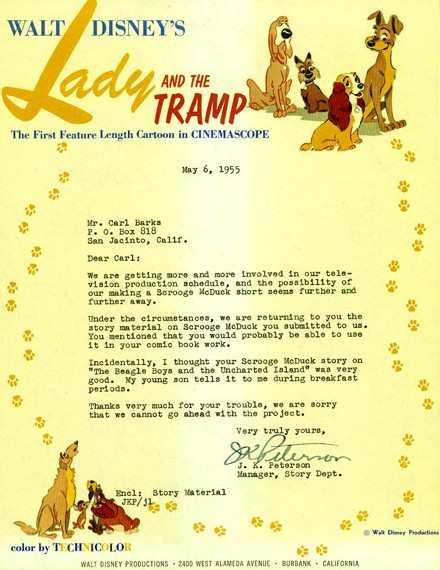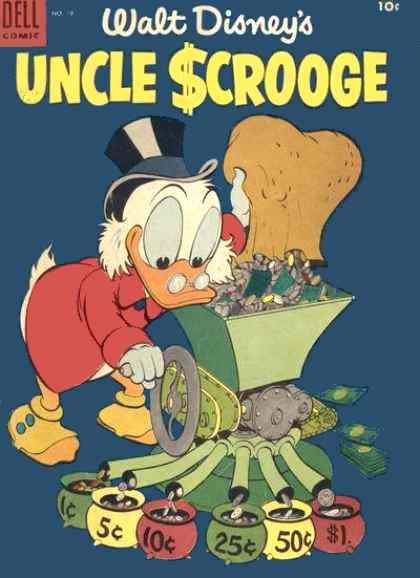BACKING
DOWN
Peterson wrote a new letter to
Barks on February 14th, 1955. Barks had visited the
Disney Studio shortly before and seen the storyboards for
a cartoon with Scrooge and Donald. It is obvious, from
Peterson's letter, that Barks' synopsis had not been
followed: We are still working on the Scrooge McDuck
and Donald idea we had on the board at the time you were
here. We hope to shape this story up for a first effort.
We may still be interested in using your story idea at a
later date...
THE
MOUSE STORY
Peterson also told Barks that the
Studio wanted to keep his script for another month or so,
unless Barks wanted to use it for a comic book. But Barks
never used his synopsis as basis for a comic book. He
later said: I just didn't have quite enough action. I
would need to have jazzed it up and introduced some
clouds of rats, or something. In other words, it would
have been a story that starred Uncle Scrooge, and the
kids and Donald wouldn't have had enough to do with it. I
would have had to have used them in there.
But, just the year before, Barks had in fact used
fragments of the plot in one of his stories. In WDCS171
'Impervi-waxing the Money Bin' Donald is working
in Scrooge's Money Bin when a mouse enters and has to be
caught. Then, suddenly, the story changes completely
venturing into a tale of the whole Bin being sealed by
special wax. What happened to the menacing mouse was
never explained...
REAL
PROBLEMS
Peterson did keep the script until
May 6th, 1955. Then he returned it with a letter
explaining that the Studio was heavily involved in
television production, and that the chance of producing a
Scrooge cartoon was remote. One of the reasons was indeed
that Disney had decided to further explore their
engagements with the upcoming media Television, but other
main factors contributed; the Studio found it difficult
to come up with ideas for cartoon shorts starring a
grumpy sourpuss of an old miser, and another very real
problem was to find a credible voice for such a character.
SCROOGE
ON THE SCREEN
Much later the Studio did manage to
come up with two Scrooge cartoons, but they were both of
a special type tailor-made for the character. In 1967 he
starred in a double-length cartoon Scrooge McDuck and
Money, which was an educational walk-through about
currency and its history, economics, and investing. Of
course, Scrooge was the obvious choice for such a
participation. In 1983 Scrooge was again the obvious
choice in the half-hour cartoon Mickey's Christmas
Carol, which is based loosely on Charles Dickens' A
Christmas Carol featuring an old miser by the name
of - Scrooge.
Scrooge also entered the world of television when in 1987
he starred in a long-running series titled DuckTales, but
living pictures never became Scrooge's medium. He was
born by Barks to the world of comic books and here he has
survived big-time!
|

